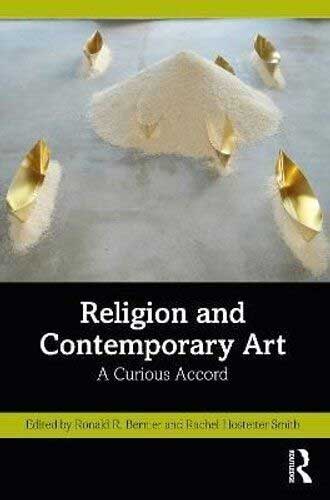
Religion and Contemporary Art: A Curious Accord,edited by R.R. Bernier and R. Hostetter Smith
(Routledge, 2023, ISBN 9781032354170)
A ‘strange place’, a ‘fractious embrace’ and a ‘curious accord’: the titles of key books exploring the interaction between art and religion from modernism through to our own post-secular world suggest a developing rapprochement.
The starting point for discussion of the accord between these two strange bedfellows is James Elkins’ from 2004 which described the strange place of religion in contemporary art. By this Elkins meant the significant interest in the interaction between the two among artists and the almost complete inability of critics, curators, educators and historians to engage with this interest. For the latter group contemporary art was a secular enterprise and a contributor to the secularisation of the West that was supposed to result in the death of religion. To have acknowledged the religious interests of modern artists could have fatally holed the secular ship as it steamed towards its inevitable destination.
Elkins’ book either catalyzed or acted as a focus for a counter-movement which discussed the real engagement of many modern and contemporary artists with religion in its many organised and less structured forms. This book documents, categorises and discusses some of the resulting conversations which have been assisted by post-modernism’s focus on small and hidden stories and by post-secularism which acknowledges that religions are changing but not dying as a result of the growth of secularism in the West.
Structured in terms of three distinct sections bookended by an Introduction and Afterword colloquy, the book explores the evolving discourse of art and religion in our contemporary era, themes and strategies utilised by contemporary artists in their engagement with religion, and examples of specific artists and ideas that draw on and test the positions that are discussed in Part 1 and the strategies proposed in Part 2.
A lot of ground is covered effectively through the use of this structure. Part 1 explores theology, criticism and curation in particular, Part 2, icons and relics, pilgrimage and site, priests and prophets, sacraments and shaman, while Part 3 ranges from Andy Warhol to John August Swanson via the likes of Lia Chavez, Theaster Gates, Christian Jankowski, and Tim Rollins and K.O.S.
Building on the editors’ Introduction, Jonathan A. Anderson adds to their mapping of the field with four useful interpretive horizons – anthropological, political, spiritual and theological – all grounded in specific examples of relatively recent exhibitions. Key contributors to the evolving debate such as Eleanor Heartney, Aaron Rosen and Daniel A. Siedell are included and take the opportunity to update and add to their distinctive contributions. Other significant interlocutors – Diane Apostolos-Cappadona, Elkins himself, Ben Quash and S. Brent Rodriguez-Plate – contribute in the colloquy which forms the Afterword.
While being of particular interest to practitioners and academics, the book – by summarising earlier research and through case studies of artists and exhibitions – provides an interesting and varied introduction to this field of study and practice; one which is increasingly featuring in the programmes of major museums and galleries. The range of artists and approaches reviewed is impressive, demonstrating the extent to which what was once considered a backwater concern has, since the publication of Elkins’ book, increasingly been mainstreamed.
Although the summary and case study aspects of the book are those which will prove of most immediate use, it is the more speculative and forward-thinking elements of the book which are, perhaps, its most interesting aspect. Ideas for the future of the field and approaches that will underpin that future are a major part of the Afterword. These include the widening of the field ‘to consider newer and perhaps wider questions beyond the frame of object, content, and audience receptivity to the longer-lasting effects of artworks … in our individual journeys and those of … students, colleagues, and the larger public.’
Two of the most interesting and innovative essays in this regard are Daniel Siedell on curation and Aaron Rosen on pilgrimage. Both find connections between art and religion in the curation of exhibitions/installations/trails that begin creative conversations by creating a new temporary reality through fashioning of connections that link past and present with artefacts and ideas. The challenge, Siedell suggests, ‘is to continue to curate ever more expansive, imaginative, even radical exhibitions of art and faith and somehow and in some way live them out.’ Rosen’s pilgrimage-based case study demonstrating that happening in practice through a coming together of art and ritual.
If you are at all curious about the relationship of religion and contemporary art, then this is a book you will want to revisit as it forms a new key staging post in our developing understanding. If you are simply curious about the reasons why religion has much greater prominence in contemporary art exhibitions now than was previously the case, then this book will not only explain why but also open up a once hidden but always present seam of modern art.
Jonathan Evens
